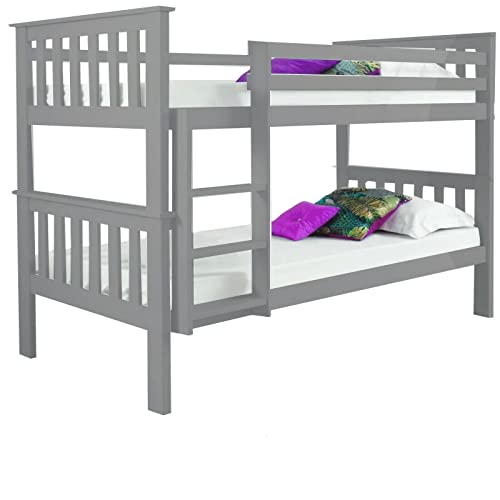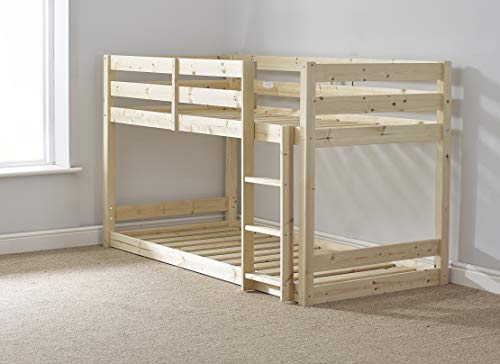Bunk Bed And Single Bed Tips That Will Change Your Life
작성자 정보
- Patty 작성
- 작성일
본문
 Choosing Between a Bunk Bed and Single Bed
Choosing Between a Bunk Bed and Single BedIt's important to consider the mattress sizes when choosing between a bunk bed or one bed. Twin size mattresses are ideal for children who are small or adult single sleepers. They are best suited to rooms measuring 7 feet by 10 inches.
Families with children of varying age groups can benefit from the twin over full bunk. The futon bunk is a popular option. It has an lower Western style futon that can be converted into a bed.
Space Saving
Bunk beds are an unique solution for households who want to maximize their space. This type of furniture allows a family to fit two beds in the same room without using the floor space which could be used for other furniture such as desks and dressers.
Bunked beds are a popular choice for kids' rooms because they can create more study and play spaces while also allowing for more space in smaller living spaces. They also make an excellent alternative to single bed frames for adults. The most sophisticated Bunkbed Single owners can incorporate accessories and decorations that can enhance their bed and make the beds appear more cozy.
The main benefit of bunk beds is that they allow children to share rooms and sleep in the same room with their parents. This arrangement can lessen conflict in the home, by giving children the opportunity to share a room. This arrangement could increase the amount and variety of storage available in the bedroom of a child, by eliminating the need for furniture that is large like dressers.
There are many types of bunk beds. However they all share similar designs that maximize space. A standard bunk bed has two identical-sized mattresses stacked on one side of the other. A full-sized twin bunk bed is arranged similarly, but has two full-size mattresses on the bottom and a twin-sized mattress on the top. A futon bunk is a normal bunk bed, paired with an Western-style futon couch that transforms into a sofa, is also an ideal choice for families who want an elegant, space-saving bunk bed.
While bunk beds are a less expensive option than single beds, they do require regular maintenance and repairs due to their multi-tier structure. Bunk beds can also be less accessible to those who have mobility issues or are at risk of falling than single beds. It is essential for healthcare facilities to consider balancing initial costs and long-term value when selecting bedding solutions for their facility.
single bunk beds with desk beds can be more affordable to maintain than bunk beds, and their simple design makes them easier to clean and repair. They can be arranged to accommodate the needs of patients or accommodate changes in the room layout. This flexibility is particularly useful for healthcare facilities that have to accommodate a broad range of patient demographics.
Convenience
Bunk beds can be a great solution for families with children of different ages. A twin over full bunk arrangement is great for siblings with different preferences in sleeping. For example, younger children might prefer to be close to their parents, whereas older children might prefer to sleep on their own.
Bunk beds also save money since they reduce the number of mattresses that have to be purchased. Some bunk beds also have a built-in system of storage that eliminates the necessity for separate dressers. This reduces the clutter in rooms for patients and makes the most of space.
Another benefit of bunk beds is their capacity to aid facilities in increasing the capacity of beds. They are ideal for crowded rooms such as rehabilitation and youth psychiatric facilities where patients share accommodation. They can be stacked in long-term care facilities to accommodate large crowds.
While bunk beds can provide a variety of advantages, they can be more difficult to maintain and clean than Single bed bunk bed with desk beds. The additional strain on frames and joints can lead to increased wear and tear, which will require more frequent inspections and maintenance. The bunk bed design can also pose accessibility issues for people with mobility issues or health issues that are specific to them. Climbing up and down the ladder can be difficult and potentially hazardous especially for older people.
Single beds, on the other hand can be moved around to fit various room layouts and provide patients with a customized environment. Journal of Environmental Psychology states that this flexibility improves the level of satisfaction of the occupant by 25 percent.
When choosing the right kind of bed for your facility, think about your patient demographics as well as your space and maintenance requirements. Bunk beds are excellent options for facilities looking to conserve space or require less setup time. Single beds are a good choice for rooms with high turnover or low budgets.
Choose a model with a mattress that is easy to clean when you are looking at bunk beds. The best mattresses for bunk beds are innerspring, latex, memory foam or hybrid. However, some patients prefer futon. When you purchase a bunk bed, be sure to see if the mattress is upholstered or slatted. A bunk bed with slats is the slats that are on the base, or slat rolls, that are screwed or hammered together to support the mattress.
Safety
When it comes to furnishing an health facility, bed safety is a major consideration. Bunk beds are able to create a safe and secure environment for patients, by efficiently using space while minimizing risk. They also have the advantage of reducing the risk of injury by providing a lower centre of gravity, which is beneficial for elderly and physically disabled people.
Regular maintenance and a proper assembly are the most important factors for bunk bed security. Examine for unstable or loose pieces and reinforce any weak points to prevent structural failure. Adhere to manufacturer-recommended weight limits, as excess loading can compromise stability. To avoid falling or entrapment, make sure that ladders are secured to the frame.
Children are allowed to sleep on the top bunk only after demonstrating their ability to safely climb up and down. They should also be able to manage their personal hygiene independently without assistance or supervision, for instance, using the restroom and dressing. In addition, bunk beds need to be positioned far enough from windows to limit the chance of injury due to windows.
One disadvantage of bunk beds is their lack of movement and noise isolation which may annoy light sleepers. Those sleeping on the bottom bunk could see their friends tossing and turning in their beds or hear them swaying up and down in the night.
Single beds, on the other hand, offer greater mobility and sound isolation. They also have enough flexibility to accommodate a range of patient demographics as well as the size of rooms.
The budget and specific needs of a facility will determine the type of bed to select. A bunk bed is a budget-friendly alternative for hospitals with limited space and a high turnover rate, while single beds are ideal for long-term care units as well as rehabilitation centers with consistent populations. Ultimately, it is important to balance the initial cost with long-term value, while focusing on the patient's security and comfort. All beds require regular inspections and prompt maintenance, regardless of type. The Facilities Management Journal reports that a proactive maintenance strategy can reduce repair costs by as much as 15 percent.
Functionality
In addition to the obvious space-saving benefits Bunk beds can also create a sense of community between siblings or friends sharing the same room. They are ideal for a family with children of varying ages or children who wish to share a space, and they can also be used well in rehabilitation facilities or youth psychiatric facilities where patients need to be able to sleep in a crowded setting.
Bunk beds are available in a variety of configurations, and some even have built-in storage. Twin over full bunks, which are extremely popular have a twin mattress at the bottom and a double mattress on top. This is perfect for families with children of various age or adults who wish to share a large bed with a partner or a friend. L-shaped bunks are a stylish alternative to the traditional bunk layout. The lower portion of the unit is an ottoman that can be used as a couch, or rearranged to create double beds.
While bunk beds save on space, they may require more maintenance than single beds because of their multi-tier design. This can include more frequent repairs and regular inspections to ensure safety, as highlighted by the Facilities Management Journal. single bunk bed with desk beds are less expensive and are easier to maintain.
When choosing bunk beds, you must also take into consideration that they provide less privacy since guests share the same space. Some people may find this difficult, especially in shared accommodation settings like rehabilitation centers or transitional homes.
Single and bunk beds can be made custom with additional features like desks or storage solutions to create a more practical sleeping environment. This is especially beneficial in small rooms that need to maximize space usage, as they can assist in eliminating clutter and make room for other activities or furniture. Some bunk beds are even divided into two beds. This allows them to develop with the child, and continue to offer comfort as they transition into adulthood.

관련자료
-
이전
-
다음
댓글 0
등록된 댓글이 없습니다.
